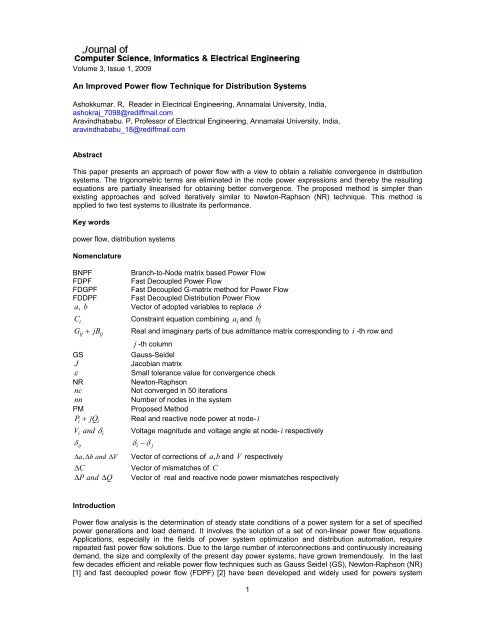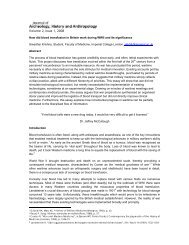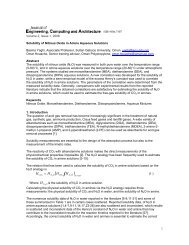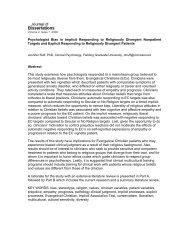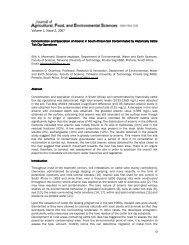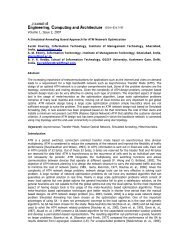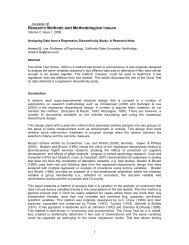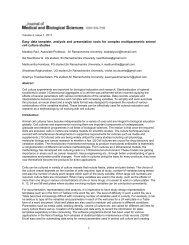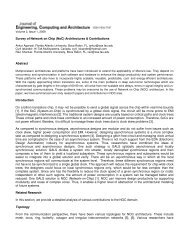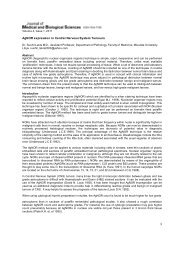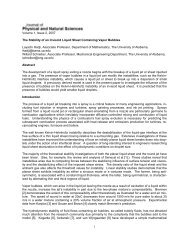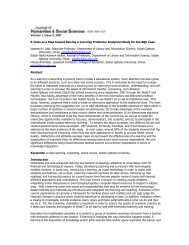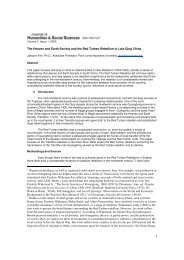An Improved Power flow Technique for Distribution Systems
An Improved Power flow Technique for Distribution Systems
An Improved Power flow Technique for Distribution Systems
Create successful ePaper yourself
Turn your PDF publications into a flip-book with our unique Google optimized e-Paper software.
Volume 3, Issue 1, 2009<br />
<strong>An</strong> <strong>Improved</strong> <strong>Power</strong> <strong>flow</strong> <strong>Technique</strong> <strong>for</strong> <strong>Distribution</strong> <strong>Systems</strong><br />
Ashokkumar. R, Reader in Electrical Engineering, <strong>An</strong>namalai University, India,<br />
ashokraj_7098@rediffmail.com<br />
Aravindhababu. P, Professor of Electrical Engineering, <strong>An</strong>namalai University, India,<br />
aravindhababu_18@rediffmail.com<br />
Abstract<br />
This paper presents an approach of power <strong>flow</strong> with a view to obtain a reliable convergence in distribution<br />
systems. The trigonometric terms are eliminated in the node power expressions and thereby the resulting<br />
equations are partially linearised <strong>for</strong> obtaining better convergence. The proposed method is simpler than<br />
existing approaches and solved iteratively similar to Newton-Raphson (NR) technique. This method is<br />
applied to two test systems to illustrate its per<strong>for</strong>mance.<br />
Key words<br />
power <strong>flow</strong>, distribution systems<br />
Nomenclature<br />
BNPF<br />
Branch-to-Node matrix based <strong>Power</strong> Flow<br />
FDPF<br />
Fast Decoupled <strong>Power</strong> Flow<br />
FDGPF Fast Decoupled G-matrix method <strong>for</strong> <strong>Power</strong> Flow<br />
FDDPF Fast Decoupled <strong>Distribution</strong> <strong>Power</strong> Flow<br />
a, b<br />
Vector of adopted variables to replace δ<br />
C i<br />
Constraint equation combining ai<br />
and bi<br />
G + Real and imaginary parts of bus admittance matrix corresponding to i -th row and<br />
ij jB ij<br />
j -th column<br />
GS<br />
Gauss-Seidel<br />
J<br />
Jacobian matrix<br />
ε<br />
Small tolerance value <strong>for</strong> convergence check<br />
NR<br />
Newton-Raphson<br />
nc<br />
Not converged in 50 iterations<br />
nn<br />
Number of nodes in the system<br />
PM<br />
Proposed Method<br />
P + Real and reactive node power at node- i<br />
i jQ i<br />
Vi and δ i Voltage magnitude and voltage angle at node- i respectively<br />
δ − δ<br />
δ ij<br />
i j<br />
∆ a, ∆b<br />
and ∆V<br />
Vector of corrections of a,b and V respectively<br />
∆ C<br />
Vector of mismatches of C<br />
∆ P and ∆Q<br />
Vector of real and reactive node power mismatches respectively<br />
Introduction<br />
<strong>Power</strong> <strong>flow</strong> analysis is the determination of steady state conditions of a power system <strong>for</strong> a set of specified<br />
power generations and load demand. It involves the solution of a set of non-linear power <strong>flow</strong> equations.<br />
Applications, especially in the fields of power system optimization and distribution automation, require<br />
repeated fast power <strong>flow</strong> solutions. Due to the large number of interconnections and continuously increasing<br />
demand, the size and complexity of the present day power systems, have grown tremendously. In the last<br />
few decades efficient and reliable power <strong>flow</strong> techniques such as Gauss Seidel (GS), Newton-Raphson (NR)<br />
[1] and fast decoupled power <strong>flow</strong> (FDPF) [2] have been developed and widely used <strong>for</strong> powers system<br />
1
operation, control and planning. However, it has repeatedly been shown that these methods may become<br />
inefficient in the analysis of distribution systems due to the following facts.<br />
<strong>Distribution</strong> networks can be numerically ill-conditioned due to wide range of r / x ratios and the<br />
inherent radial structure<br />
<strong>Distribution</strong> power <strong>flow</strong> equations are different in nature from transmission power <strong>flow</strong> equations<br />
Consequently many power <strong>flow</strong> algorithms specially suited <strong>for</strong> distribution systems have been developed and<br />
well documented [1-16]. These methods may be roughly categorized as node and branch based methods.<br />
The first category uses node voltages or current injections as state variables and requires in<strong>for</strong>mation on the<br />
derivatives of network equations. The Z-bus method [3], NR based algorithms [4, 5] and FDPF based<br />
algorithms [6-8] belong to this category. The second category adopts branch currents or branch powers as<br />
state variables and involves only basic circuit laws. The backward/<strong>for</strong>ward sweep based methods [9-15] and<br />
loop impedance [16] based methods fall in this category.<br />
A fast decoupled G-matrix method <strong>for</strong> power <strong>flow</strong> (FDGPF) of distribution systems, based on equivalent<br />
current injections has been proposed in [7]. This method uses a constant and symmetric Jacobian matrix,<br />
which needs to be factorized only once. However, the Jacobian matrix has been <strong>for</strong>med by omitting the<br />
reactance of the distribution lines with the assumption that r >> x . A fast decoupled distribution power <strong>flow</strong><br />
(FDDPF) based on equivalent line current <strong>flow</strong>s, which are rotated by appropriate line admittance angle <strong>for</strong><br />
decoupling the problem, has been suggested in [8]. A compensation based technique that exploits radial<br />
structure to achieve high speed, robust convergence and low memory requirement, <strong>for</strong> weakly meshed<br />
distribution systems has been explained in [9]. A simple and efficient branch-to-node matrix based power<br />
<strong>flow</strong> (BNPF) <strong>for</strong> radial distribution systems has been presented in [10].<br />
Most of the existing algorithms, suggested in the literature, have been developed with an objective to reduce<br />
the computational burden by reducing the number of equations, approximating the Jacobian matrix, etc.<br />
However, this paper presents a new distribution power <strong>flow</strong> technique with a different objective in the sense it<br />
attempts to enhance the convergence rate by partially linearising the power <strong>flow</strong> equations. The proposed<br />
method is applied on two test systems to reveal its per<strong>for</strong>mance and the results are presented.<br />
Proposed <strong>Power</strong> Flow Method<br />
The power <strong>flow</strong> equations are partially linearised by eliminating the trigonometric terms. This elimination will<br />
improve the convergence of the power <strong>flow</strong> algorithm and makes the algorithm suitable <strong>for</strong> ill-conditioned<br />
distribution systems.<br />
The expressions <strong>for</strong> the real and reactive bus powers, P and Q are,<br />
i<br />
2<br />
i<br />
P = V<br />
i<br />
G<br />
2<br />
i<br />
ii<br />
Q = −V<br />
B<br />
The above two equations can be modified as<br />
ii<br />
+<br />
+<br />
nn<br />
∑<br />
j=<br />
1<br />
j≠i<br />
nn<br />
∑<br />
V V<br />
i<br />
i<br />
j=<br />
1<br />
j≠i<br />
j<br />
j<br />
[<br />
[<br />
G<br />
ij<br />
ij<br />
i<br />
i<br />
cosδ + B sin δ ]<br />
ij<br />
ij<br />
ij<br />
ij<br />
ij<br />
ij<br />
]<br />
VV G sinδ − B cosδ<br />
(2)<br />
(1)<br />
where<br />
a<br />
b<br />
i<br />
i<br />
= cosδ<br />
= sinδ<br />
i<br />
i<br />
i<br />
2<br />
i<br />
P = V G<br />
ii<br />
2<br />
i<br />
Q = −V<br />
B<br />
i<br />
+<br />
ii<br />
nn<br />
∑<br />
VV<br />
i<br />
j=<br />
1<br />
j≠i<br />
+<br />
nn<br />
∑<br />
j<br />
VV<br />
i<br />
j=<br />
1<br />
j≠i<br />
[ G ( a a + b b ) + B ( b a − a b )]<br />
j<br />
ij<br />
i<br />
j<br />
i<br />
j<br />
[ G ( b a − a b ) − B ( a a + b b )]<br />
ij<br />
i<br />
j<br />
i<br />
j<br />
ij<br />
ij<br />
i<br />
j<br />
i<br />
j<br />
i<br />
j<br />
i<br />
j<br />
(3)<br />
(4)<br />
(5)<br />
2
Start<br />
Read the radial system data, load data,<br />
source node voltage V o, etc.<br />
Initialise all the adopted variables and<br />
voltage magnitudes<br />
ai<br />
= 1 ⎫<br />
⎪<br />
bi<br />
= 0 ⎬ i = 1,2.. nn<br />
Vi<br />
= V<br />
⎪<br />
o⎭<br />
Form the Jacobian Matrix J<br />
Compute mismatch vector<br />
[ ∆ P ∆Q<br />
∆C<br />
] T<br />
Update the adopted variables and<br />
voltage magnitudes<br />
a = a+∆a<br />
b = b+∆b<br />
V = V +∆V<br />
Solve Eq (7) <strong>for</strong> [ ∆ a ∆b<br />
∆V<br />
] T<br />
Test <strong>for</strong> convergence<br />
Max ∆ P ∆Q<br />
∆C<br />
: ε<br />
Greater<br />
Less or equal<br />
Compute δ using Eq (8)<br />
Solution is obtained. Print the results<br />
Stop<br />
Fig. 1 Flowchart of the proposed method<br />
3
The ai<br />
and bi<br />
terms in the above equations may be combined through a constraint as<br />
2 2<br />
i = i i<br />
C a + b −1<br />
= 0<br />
(6)<br />
o<br />
Eqs. 3, 4 and 6 <strong>for</strong> all the nodes except source node are linearised around a known operating point of a ,<br />
o o<br />
b and V ,<br />
⎡<br />
⎢<br />
⎢<br />
⎢⎣<br />
⎤ ⎡ ∆a<br />
⎤ ⎡∆P⎤<br />
J<br />
⎥ ⎢ ⎥<br />
=<br />
⎢ ⎥<br />
⎥ ⎢<br />
∆b<br />
⎥ ⎢<br />
∆Q<br />
(7)<br />
⎥<br />
⎥⎦<br />
⎢⎣<br />
∆V<br />
⎥⎦<br />
⎢⎣<br />
∆C⎥⎦<br />
where<br />
⎡ ∂P<br />
∂P<br />
∂P<br />
⎤<br />
⎢<br />
∂a<br />
∂b<br />
∂V<br />
⎥<br />
⎢<br />
∂Q<br />
∂Q<br />
∂Q<br />
⎥<br />
J = ⎢<br />
⎥ = Jacobian matrix<br />
⎢ ∂a<br />
∂b<br />
∂V<br />
⎥<br />
⎢∂C<br />
∂C<br />
∂C<br />
⎥<br />
⎢<br />
⎥<br />
⎣ ∂a<br />
∂b<br />
∂V<br />
⎦<br />
The expression <strong>for</strong> the derivatives of the Jacobian matrix, J , are given in Appendix-1. Eq. (7) may be solved<br />
iteratively <strong>for</strong> a , b and V . Once the adopted unknowns a and b are computed, the node angles can be<br />
computed as<br />
The <strong>flow</strong> of the proposed algorithm is given in Fig. 1.<br />
δ i = sin −1 b i<br />
(8)<br />
Simulation Results<br />
The proposed algorithm is tested to evaluate its solution accuracy and computational efficiency on 15 and 69<br />
node distribution systems [14, 17] using a Pentium-IV, 2 GHz, personal computer. The convergence<br />
sensitivity of the proposed method (PM) to r / x ratio of the distribution lines is also tested. Two series of<br />
tests are generated, one by varying the base case resistance and the other by changing the base case<br />
reactance using a uni<strong>for</strong>m scaling factor, keeping the latter parameter unchanged. The results obtained by<br />
the PM are compared with that of a node based method FDDPF [8], a branch based method BNPF [10] and<br />
a decoupled method FDGPF [7] to highlight its superior per<strong>for</strong>mance. The first two methods are chosen to<br />
demonstrate the convergence per<strong>for</strong>mance and the third one is selected to show the robustness of the PM.<br />
The algorithms are tested with a flat start and a convergence tolerance of 0.0001 per unit.<br />
The solution of the PM <strong>for</strong> the 15-node system with base case reactance multiplied by a scaling factor of 0.5<br />
is compared with the solution obtained by FDDPF, BNPF and FDGPF methods in Table-1. This table<br />
indicates that the PM offers the same solution as that obtained by the other methods, which validates its<br />
solution accuracy. Table-2 explains the convergence characteristics in terms of number of iterations. The<br />
PM reliably converges <strong>for</strong> all test systems with a wide variation in r / x ratio of the distribution lines similar to<br />
FDDPF and BNPF methods. But the FDGPF needs a higher r / x ratio <strong>for</strong> convergence even <strong>for</strong> smaller<br />
systems and diverges <strong>for</strong> 69 node system irrespective of the r / x ratio. It is very clear that the PM is<br />
insensitive to r / x ratio and offers solution <strong>for</strong> even larger systems unlike FDGPF method. These results<br />
summarize that the PM is accurate, fast and robust and is suitable <strong>for</strong> larger distribution systems.<br />
4
Table 1 <strong>Power</strong> <strong>flow</strong> solution obtained <strong>for</strong> 15-node system<br />
Node PM FDDPF BNPF FDGPF<br />
No V δ V δ V δ V δ<br />
1<br />
2<br />
3<br />
4<br />
5<br />
6<br />
7<br />
8<br />
9<br />
10<br />
11<br />
12<br />
13<br />
14<br />
15<br />
1.0000 0.0000<br />
0.9786 0.0074<br />
0.9678 0.0113<br />
0.9635 0.0129<br />
0.9628 0.0133<br />
0.9616 0.0139<br />
0.9617 0.0138<br />
0.9625 0.0141<br />
0.9593 0.0158<br />
0.9583 0.0163<br />
0.9760 0.0088<br />
0.9752 0.0092<br />
0.9684 0.0128<br />
0.9666 0.0137<br />
0.9673 0.0133<br />
1.0000 0.0000<br />
0.9787 0.0074<br />
0.9679 0.0113<br />
0.9636 0.0129<br />
0.9628 0.0133<br />
0.9617 0.0139<br />
0.9618 0.0138<br />
0.9626 0.0141<br />
0.9594 0.0158<br />
0.9583 0.0163<br />
0.9761 0.0088<br />
0.9752 0.0092<br />
0.9684 0.0127<br />
0.9666 0.0137<br />
0.9674 0.0133<br />
1.0000 0.0000<br />
0.9786 0.0074<br />
0.9678 0.0113<br />
0.9635 0.0129<br />
0.9628 0.0133<br />
0.9616 0.0139<br />
0.9617 0.0138<br />
0.9625 0.0141<br />
0.9593 0.0158<br />
0.9583 0.0163<br />
0.9760 0.0088<br />
0.9752 0.0092<br />
0.9684 0.0128<br />
0.9666 0.0137<br />
0.9673 0.0133<br />
1.0000 0.0000<br />
0.9787 0.0074<br />
0.9679 0.0113<br />
0.9637 0.0128<br />
0.9629 0.0132<br />
0.9617 0.0139<br />
0.9619 0.0138<br />
0.9626 0.0140<br />
0.9594 0.0157<br />
0.9584 0.0163<br />
0.9761 0.0088<br />
0.9752 0.0092<br />
0.9684 0.0127<br />
0.9667 0.0136<br />
0.9674 0.0133<br />
Table 2 Number of iterations<br />
15 node 69 node<br />
PM FDDPF BNPF FDGPF PM FDDPF BNPF FDGPF<br />
r + j x 4 4 4 nc 6 5 5 nc<br />
0.5 r + j x 4 3 3 nc 5 4 4 nc<br />
1.5 r + j x 4 4 4 16 6 6 6 nc<br />
r + j 0.5 x 4 3 3 9 7 5 5 nc<br />
r + j 1.5 x 4 4 4 nc 5 5 5 nc<br />
Conclusion<br />
A reliable power <strong>flow</strong> algorithm has been developed <strong>for</strong> distribution systems. The convergence<br />
characteristics of this <strong>for</strong>mulation has been improved by replacing the trigonometric terms cos δ and sin δ<br />
of the traditional power <strong>flow</strong> equations by a new set of variables a and b respectively along with the<br />
necessary additional constraint equations. The results have been compared with the existing techniques to<br />
highlight the superiority of the proposed approach. The approach is well suited <strong>for</strong> practical implementations.<br />
Acknowledgements<br />
The authors gratefully acknowledge the authorities of <strong>An</strong>namalai University <strong>for</strong> the facilities offered to carry<br />
out this work.<br />
5
Appendix-1<br />
Expression <strong>for</strong> derivatives of the Jacobian matrix<br />
[ ]<br />
[ ]<br />
[ ]<br />
[ ]<br />
( ) (<br />
[ ]<br />
)<br />
( ) ( )<br />
[ ]<br />
j<br />
i<br />
j<br />
i<br />
ij<br />
j<br />
i<br />
j<br />
i<br />
ij<br />
i<br />
j<br />
i<br />
nn<br />
i<br />
j<br />
j<br />
j<br />
i<br />
j<br />
i<br />
ij<br />
j<br />
i<br />
j<br />
i<br />
ij<br />
j<br />
ii<br />
i<br />
i<br />
i<br />
i<br />
ij<br />
i<br />
ij<br />
j<br />
i<br />
j<br />
i<br />
nn<br />
i<br />
j<br />
j<br />
j<br />
ij<br />
j<br />
ij<br />
j<br />
i<br />
i<br />
i<br />
i<br />
ij<br />
i<br />
ij<br />
j<br />
i<br />
j<br />
i<br />
nn<br />
i<br />
j<br />
j<br />
j<br />
ij<br />
j<br />
ij<br />
j<br />
i<br />
i<br />
i<br />
b<br />
a<br />
a<br />
b<br />
B<br />
b b<br />
a<br />
a<br />
G<br />
V<br />
V<br />
P<br />
b<br />
a<br />
a<br />
b<br />
B<br />
b b<br />
a<br />
a<br />
G<br />
V<br />
V G<br />
V<br />
P<br />
a<br />
B<br />
b<br />
G<br />
V V<br />
b<br />
P<br />
a<br />
B<br />
b<br />
G<br />
V V<br />
b<br />
P<br />
b<br />
B<br />
a<br />
G<br />
V V<br />
a<br />
P<br />
b<br />
B<br />
a<br />
G<br />
V V<br />
a<br />
P<br />
−<br />
+<br />
+<br />
=<br />
∂<br />
∂<br />
−<br />
+<br />
+<br />
+<br />
=<br />
∂<br />
∂<br />
−<br />
=<br />
∂<br />
∂<br />
+<br />
=<br />
∂<br />
∂<br />
+<br />
=<br />
∂<br />
∂<br />
−<br />
=<br />
∂<br />
∂<br />
∑<br />
∑<br />
∑<br />
≠<br />
=<br />
≠<br />
=<br />
≠<br />
=<br />
1<br />
1<br />
1<br />
2<br />
[ ]<br />
[ ]<br />
[ ]<br />
[ ]<br />
( ) (<br />
[ ]<br />
)<br />
( ) ( )<br />
[ ]<br />
j<br />
i<br />
j<br />
i<br />
ij<br />
j<br />
i<br />
j<br />
i<br />
ij<br />
i<br />
j<br />
i<br />
nn<br />
i<br />
j<br />
j<br />
j<br />
i<br />
j<br />
i<br />
ij<br />
j<br />
i<br />
j<br />
i<br />
ij<br />
j<br />
ii<br />
i<br />
i<br />
i<br />
i<br />
ij<br />
i<br />
ij<br />
j<br />
i<br />
j<br />
i<br />
nn<br />
i<br />
j<br />
j<br />
j<br />
ij<br />
j<br />
ij<br />
j<br />
i<br />
i<br />
i<br />
i<br />
ij<br />
i<br />
ij<br />
j<br />
i<br />
j<br />
i<br />
nn<br />
i<br />
j<br />
j<br />
j<br />
ij<br />
j<br />
ij<br />
j<br />
i<br />
i<br />
i<br />
b b<br />
a<br />
a<br />
B<br />
b<br />
a<br />
a<br />
b<br />
G<br />
V<br />
V<br />
Q<br />
b b<br />
a<br />
a<br />
B<br />
b<br />
a<br />
a<br />
b<br />
G<br />
V<br />
B<br />
V<br />
V<br />
Q<br />
b<br />
B<br />
a<br />
G<br />
V V<br />
b<br />
Q<br />
b<br />
B<br />
a<br />
G<br />
V V<br />
b<br />
Q<br />
a<br />
B<br />
b<br />
G<br />
V V<br />
a<br />
Q<br />
a<br />
B<br />
b<br />
G<br />
V V<br />
a<br />
Q<br />
+<br />
−<br />
−<br />
=<br />
∂<br />
∂<br />
+<br />
−<br />
−<br />
+<br />
−<br />
=<br />
∂<br />
∂<br />
−<br />
−<br />
=<br />
∂<br />
∂<br />
−<br />
=<br />
∂<br />
∂<br />
−<br />
=<br />
∂<br />
∂<br />
−<br />
−<br />
=<br />
∂<br />
∂<br />
∑<br />
∑<br />
∑<br />
≠<br />
=<br />
≠<br />
=<br />
≠<br />
=<br />
1<br />
1<br />
1<br />
2<br />
0<br />
2<br />
2<br />
=<br />
∂<br />
∂<br />
=<br />
∂<br />
∂<br />
=<br />
∂<br />
∂<br />
i<br />
i<br />
i<br />
i<br />
i<br />
i<br />
i<br />
i<br />
V<br />
C<br />
b<br />
b<br />
C<br />
a<br />
a<br />
C<br />
0<br />
0<br />
0<br />
=<br />
∂<br />
∂<br />
=<br />
∂<br />
∂<br />
=<br />
∂<br />
∂<br />
j<br />
i<br />
j<br />
i<br />
j<br />
i<br />
V<br />
C<br />
b<br />
C<br />
a<br />
C<br />
6
Appendix-2<br />
Data <strong>for</strong> 15-node <strong>Distribution</strong> System<br />
12<br />
11<br />
7<br />
1 2 3 4 5<br />
13<br />
14 15<br />
8 6<br />
9<br />
10<br />
Fig. 2 One line diagram<br />
Table 3 Line data<br />
Sending Receiving<br />
node node<br />
r (ohm) x (ohm)<br />
1 2 1.35309 1.32349<br />
2 3 1.17024 1.14464<br />
3 4 0.84111 0.82271<br />
4 5 1.52348 1.02760<br />
4 6 1.19702 0.80740<br />
4 7 2.23081 1.50470<br />
3 8 1.79553 1.21110<br />
8 9 2.44845 1.65150<br />
9 10 2.01317 1.35790<br />
2 11 2.01317 1.35790<br />
11 12 1.68671 1.13770<br />
2 13 2.55727 1.72490<br />
13 14 1.08820 0.73400<br />
13 15 1.25143 0.84410<br />
Table 4 Load data<br />
Node No<br />
Load ( kW + j kVAr)<br />
2, 5, 10, 12 44.10 + j 44.99<br />
3, 7, 9, 11, 15 70.00 + j 71.41<br />
4, 6, 8, 13, 14 140 + j 142.82<br />
References<br />
1. W. F. Tinney and C. E. Hart, <strong>Power</strong> <strong>flow</strong> solution by Newton’s method, IEEE Trans. PAS-86, pp.<br />
1449-1460, 1967.<br />
2. B. Stott, O. Alsac, Fast decoupled load <strong>flow</strong>, IEEE Trans. <strong>Power</strong> Apparatus and <strong>Systems</strong>, Vol.<br />
PAS-93, pp. 859-869, 1974.<br />
3. T. H. Chen, M. S. Chen, K. J Hwang, P. Kotas and E. A. Chebli, <strong>Distribution</strong> system power <strong>flow</strong><br />
analysis-a rigid approach, IEEE Trans. on <strong>Power</strong> Delivery, Vol. 6, No.3, pp.1146-1152, 1991.<br />
7
4. Fan Zhang and Carol. S. Cheng, A modified Newton method <strong>for</strong> radial distribution system power<br />
<strong>flow</strong> analysis, IEEE Trans. on <strong>Power</strong> <strong>Systems</strong>, Vol.12, No.1, pp. 389-397, 1997.<br />
5. J. H. Teng, A novel and fast three-phase load <strong>flow</strong> <strong>for</strong> unbalanced radial distribution systems, IEEE<br />
Trans. on <strong>Power</strong> <strong>Systems</strong>, Vol.17, No. 4, pp. 1238-1244, 2002.<br />
6. P. Aravindhababu, A new fast decoupled power <strong>flow</strong> method <strong>for</strong> distribution systems, Electric<br />
<strong>Power</strong> Components and <strong>Systems</strong>, Vol.31, No.9, pp. 869-878, 2003.<br />
7. Whei-Min Lin, Jen-Hao Teng, Three-phase distribution network fast-decoupled power <strong>flow</strong><br />
solutions, International Journal of Electrical <strong>Power</strong> and Energy <strong>Systems</strong>, Vol. 22, No.5, pp. 375-<br />
380, 2000.<br />
8. P. Aravindhababu and R. Ashokkumar, A fast decoupled power <strong>flow</strong> <strong>for</strong> distribution systems,<br />
Electric <strong>Power</strong> Components and <strong>Systems</strong>, Vol.36, No.9, pp. 932-940, 2008.<br />
9. D. Shirmohammadi, H. W. Hong, A. Semlyen, and G. X. Luo, A compensation based power <strong>flow</strong><br />
method <strong>for</strong> weakly meshed distribution networks, IEEE Trans. on <strong>Power</strong> <strong>Systems</strong>, Vol.3, No.2,<br />
pp.753-762, 1998.<br />
10. P. Aravindhababu, S. Ganapathy and K.R. Nayar, A novel technique <strong>for</strong> the analysis of radial<br />
distribution systems, International Journal of Electrical <strong>Power</strong> and Energy <strong>Systems</strong>, Vol. 23, No. 3,<br />
pp. 167-171, 2001.<br />
11. U. Eminoglu and M. H. Hocaoglu, A new power <strong>flow</strong> method <strong>for</strong> radial distribution systems including<br />
voltage dependant load models, Electric <strong>Power</strong> <strong>Systems</strong> research, Vol. 76, No. 1-3, pp. 106-114,<br />
2005.<br />
12. W. C. Wu and B. M. Zhang, A three-phase power <strong>flow</strong> algorithm <strong>for</strong> distribution system power <strong>flow</strong><br />
based on loop-analysis method, International Journal of Electrical <strong>Power</strong> and Energy <strong>Systems</strong>, Vol.<br />
30, No. 1, pp. 8-15, 2008.<br />
13. S. Satyanarayana, T. Ramana, S. Singararaju and G. K. Rao, <strong>An</strong> efficient load <strong>flow</strong> solution <strong>for</strong><br />
radial distribution network including voltage dependent load models, Electric <strong>Power</strong> Components<br />
and <strong>Systems</strong>, Vol.35, No. 5, pp. 539-551, 2007.<br />
14. D. Das, D. P. Kothari and A. Kalam, Simple and efficient method <strong>for</strong> load <strong>flow</strong> solution of radial<br />
distribution networks, International Journal of Electric <strong>Power</strong> and Energy <strong>Systems</strong>, Vol. 17, No. 5,<br />
pp.335-346, 1995.<br />
15. G. Renato Cespedes, New Method <strong>for</strong> the <strong>An</strong>alysis of <strong>Distribution</strong> Networks, IEEE Trans. on<br />
<strong>Power</strong> Delivery, Vol. 5, No.1, pp.391-396, 1990.<br />
16. G. X. Luo and A. Semlyen, Efficient load <strong>flow</strong> <strong>for</strong> large weakly meshed networks, IEEE Trans. on<br />
<strong>Power</strong> <strong>Systems</strong>, Vol. 5, No.4, pp. 1309-1316, 1990.<br />
17. M. Chakravorty and D. Das, Voltage stability analysis of radial distribution networks, International<br />
Journal of Electric <strong>Power</strong> and Energy <strong>Systems</strong>, Vol. 23, No. 2, pp.129-135, 2001.<br />
8


